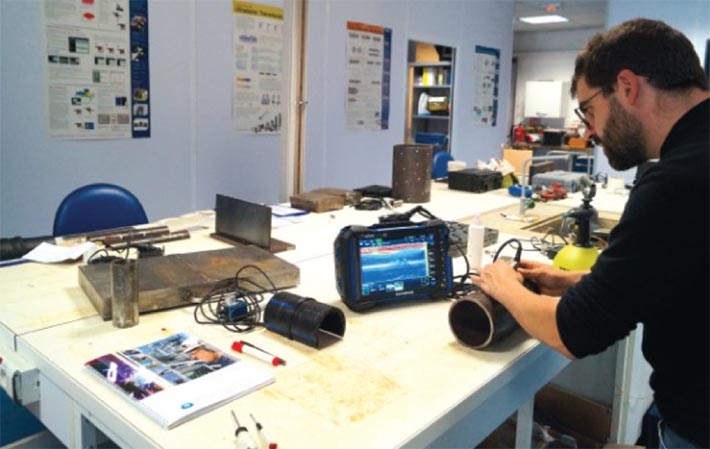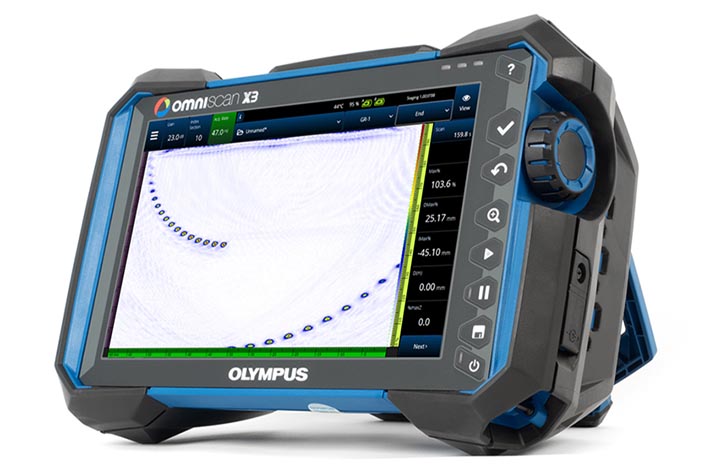Prior to the official launch of the OmniScan™ X3 phased array flaw detector, Olympus loaned a unit to the IS Expert department of the Institut de Soudure, (a France-based weld inspection group) to give its inspectors a chance to try it out. The IS Expert department oversees the development of new and innovative nondestructive testing (NDT) methods.
A UT Expert Put the OmniScan X3 to the Test and Offers His Evaluation
After conducting some in-laboratory tests with the OmniScan X3 instrument, Manuel Tessier, NDT engineer and expert in ultrasonic testing and time-of-flight diffraction (UT/TOFD) shared his view on the new features with the greatest potential for inspectors. He underlined the advantages offered by the multigroup total focusing method (TFM) capability, improved Dual Linear Array and Dual Matrix Array probe support, and the innovative Acoustic Influence Map (AIM) modeling tool.
The following is an excerpt from an article that appeared in issue no. 69 of Contrôles Essais Mesures (CEM) magazine (translated from French).

Manuel Tessier, NDT expert in UT/TOFD at the Institut de Soudure laboratory in France testing the TFM imaging capability of the OmniScan X3 flaw detector
 | “We were able to test the TFM on different reference standards. The results are conclusive.”Manuel Tessier, NDT expert in UT/TOFD at the Institut de Soudure, had the opportunity to test the new features of the OmniScan X3 instrument in a laboratory pre-launch. This was his Q&A with CEM magazine. |
CEM: Your department at the Institut de Soudure uses OmniScan instruments on a daily basis. What are they used for?
M. Tessier: OmniScan instruments are standard equipment for us. We appreciate them for their compactness, their robustness, and their reliability on site. All our personnel are trained on how to use this equipment and on the complementary software. We have around 20 flaw detectors of this type here at the Institut de Soudure. Weld inspection, mapping and thickness measurements, flaw characterization, detection of various types of damage: the IS Expert department, which I work in, uses these devices every day, either for conventional techniques (with one probe) or within a semiautomated or automated system for the inspection of welds using a combination of TOFD and phased array.
“The OmniScan X3 unit offers some interesting opportunities with these advanced probes as they can be used for some pretty specialized applications.”
CEM: What about the use of specific probes?
M. Tessier: We also use this instrument with Dual Linear Array (DLA) or Dual Matrix Array (DMA) probes. One of the advantages of the OmniScan X3 is the ease with which we can program these types of sensors. This was less convenient with the OmniScan MX2, because even if it was able to drive these probes, it didn't facilitate programming them. The OmniScan X3 unit offers some interesting opportunities with these advanced probes as they can be used for some pretty specialized applications; their focal law settings have a significant impact. This means that adjusting the settings gives you the opportunity to fine-tune the inspection. Having these types of probes integrated into the unit makes it possible to set up the focal law parameters directly in the device, which could only be done in the MX2 in a very limited way. For me, this is a big plus.
CEM: What do you think about the TFM now available on the OmniScan X3?
M. Tessier: The TFM is also a welcome feature. Until now, we used other devices that had this flaw detection mode, notably for finer analysis, because the OmniScan MX2 unit couldn't provide the data we needed. With the new OmniScan X3 unit we no longer need other flaw detectors, particularly in the detection of HTHA damage (so we can avoid needing multiple devices on site). We were able to test the TFM on different reference standards. The results were conclusive. I am eager to conduct further testing of the multigroup TFM, which offers the possibility to use up to four groups simultaneously. The AIM (Acoustic Influence Map), which doesn't exist on other devices, is another functionality that I find particularly appealing. It offers the possibility to simulate the beam and enables you to see the potential interaction in a defined zone, which is not only useful but also a good teaching tool.
Related Content
3 Ways the OmniScan X3 Flaw Detector’s Scan Plan Tool Simplifies Your Set Up
How Do You Use Our Instruments? Share Your Story!
White Paper: TFM Acoustic Influence Map
Get In Touch

